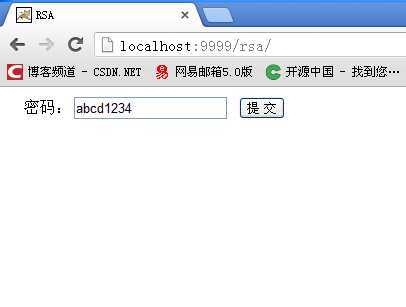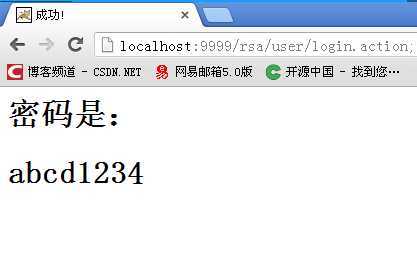标签:style blog http color os io 使用 java ar
前段时间咱老大吩咐我写一个rsa前台加密到后台用java解密。(说实话这之前我还真没用过)
不过没办法啊,这是任务,于是研究了一下。圆满完成任务了,下面共享下实现思路:
准备工作:其实鄙人也没那么强啦,第三方包是必须的
bcprov-jdk15on-148.jar
commons-codec-1.7.jar
commons-lang-2.4.jar
log4j-1.2.15.jar
slf4j-api-1.6.1.jar
package com.web.utils; import java.io.File; import java.io.FileInputStream; import java.io.FileOutputStream; import java.io.ObjectInputStream; import java.io.ObjectOutputStream; import java.math.BigInteger; import java.security.KeyPair; import java.security.KeyFactory; import java.security.KeyPairGenerator; import java.security.Provider; import java.security.PublicKey; import java.security.PrivateKey; import java.security.SecureRandom; import java.security.NoSuchAlgorithmException; import java.security.InvalidParameterException; import java.security.interfaces.RSAPublicKey; import java.security.interfaces.RSAPrivateKey; import java.security.spec.RSAPublicKeySpec; import java.security.spec.RSAPrivateKeySpec; import java.security.spec.InvalidKeySpecException; import java.util.Date; import javax.crypto.Cipher; import org.apache.commons.io.IOUtils; import org.apache.commons.io.FileUtils; import org.apache.commons.codec.DecoderException; import org.apache.commons.codec.binary.Hex; import org.bouncycastle.jce.provider.BouncyCastleProvider; import org.slf4j.Logger; import org.slf4j.LoggerFactory; import org.apache.commons.lang.StringUtils; import org.apache.commons.lang.time.DateFormatUtils; /** * RSA算法加密/解密工具类。 * * @author fuchun * @version 1.0.0, 2010-05-05 */ public abstract class RSAUtils { private static final Logger LOGGER = LoggerFactory.getLogger(RSAUtils.class); /** 算法名称 */ private static final String ALGORITHOM = "RSA"; /**保存生成的密钥对的文件名称。 */ private static final String RSA_PAIR_FILENAME = "/__RSA_PAIR.txt"; /** 密钥大小 */ private static final int KEY_SIZE = 1024; /** 默认的安全服务提供者 */ private static final Provider DEFAULT_PROVIDER = new BouncyCastleProvider(); private static KeyPairGenerator keyPairGen = null; private static KeyFactory keyFactory = null; /** 缓存的密钥对。 */ private static KeyPair oneKeyPair = null; private static File rsaPairFile = null; static { try { keyPairGen = KeyPairGenerator.getInstance(ALGORITHOM, DEFAULT_PROVIDER); keyFactory = KeyFactory.getInstance(ALGORITHOM, DEFAULT_PROVIDER); } catch (NoSuchAlgorithmException ex) { LOGGER.error(ex.getMessage()); } rsaPairFile = new File(getRSAPairFilePath()); } private RSAUtils() { } /** * 生成并返回RSA密钥对。 */ private static synchronized KeyPair generateKeyPair() { try { keyPairGen.initialize(KEY_SIZE, new SecureRandom(DateFormatUtils.format(new Date(),"yyyyMMdd").getBytes())); oneKeyPair = keyPairGen.generateKeyPair(); saveKeyPair(oneKeyPair); return oneKeyPair; } catch (InvalidParameterException ex) { LOGGER.error("KeyPairGenerator does not support a key length of " + KEY_SIZE + ".", ex); } catch (NullPointerException ex) { LOGGER.error("RSAUtils#KEY_PAIR_GEN is null, can not generate KeyPairGenerator instance.", ex); } return null; } /** * 返回生成/读取的密钥对文件的路径。 */ private static String getRSAPairFilePath() { String urlPath = RSAUtils.class.getResource("/").getPath(); return (new File(urlPath).getParent() + RSA_PAIR_FILENAME); } /** * 若需要创建新的密钥对文件,则返回 {@code true},否则 {@code false}。 */ private static boolean isCreateKeyPairFile() { // 是否创建新的密钥对文件 boolean createNewKeyPair = false; if (!rsaPairFile.exists() || rsaPairFile.isDirectory()) { createNewKeyPair = true; } return createNewKeyPair; } /** * 将指定的RSA密钥对以文件形式保存。 * * @param keyPair 要保存的密钥对。 */ private static void saveKeyPair(KeyPair keyPair) { FileOutputStream fos = null; ObjectOutputStream oos = null; try { fos = FileUtils.openOutputStream(rsaPairFile); oos = new ObjectOutputStream(fos); oos.writeObject(keyPair); } catch (Exception ex) { ex.printStackTrace(); } finally { IOUtils.closeQuietly(oos); IOUtils.closeQuietly(fos); } } /** * 返回RSA密钥对。 */ public static KeyPair getKeyPair() { // 首先判断是否需要重新生成新的密钥对文件 if (isCreateKeyPairFile()) { // 直接强制生成密钥对文件,并存入缓存。 return generateKeyPair(); } if (oneKeyPair != null) { return oneKeyPair; } return readKeyPair(); } // 同步读出保存的密钥对 private static KeyPair readKeyPair() { FileInputStream fis = null; ObjectInputStream ois = null; try { fis = FileUtils.openInputStream(rsaPairFile); ois = new ObjectInputStream(fis); oneKeyPair = (KeyPair) ois.readObject(); return oneKeyPair; } catch (Exception ex) { ex.printStackTrace(); } finally { IOUtils.closeQuietly(ois); IOUtils.closeQuietly(fis); } return null; } /** * 根据给定的系数和专用指数构造一个RSA专用的公钥对象。 * * @param modulus 系数。 * @param publicExponent 专用指数。 * @return RSA专用公钥对象。 */ public static RSAPublicKey generateRSAPublicKey(byte[] modulus, byte[] publicExponent) { RSAPublicKeySpec publicKeySpec = new RSAPublicKeySpec(new BigInteger(modulus), new BigInteger(publicExponent)); try { return (RSAPublicKey) keyFactory.generatePublic(publicKeySpec); } catch (InvalidKeySpecException ex) { LOGGER.error("RSAPublicKeySpec is unavailable.", ex); } catch (NullPointerException ex) { LOGGER.error("RSAUtils#KEY_FACTORY is null, can not generate KeyFactory instance.", ex); } return null; } /** * 根据给定的系数和专用指数构造一个RSA专用的私钥对象。 * * @param modulus 系数。 * @param privateExponent 专用指数。 * @return RSA专用私钥对象。 */ public static RSAPrivateKey generateRSAPrivateKey(byte[] modulus, byte[] privateExponent) { RSAPrivateKeySpec privateKeySpec = new RSAPrivateKeySpec(new BigInteger(modulus), new BigInteger(privateExponent)); try { return (RSAPrivateKey) keyFactory.generatePrivate(privateKeySpec); } catch (InvalidKeySpecException ex) { LOGGER.error("RSAPrivateKeySpec is unavailable.", ex); } catch (NullPointerException ex) { LOGGER.error("RSAUtils#KEY_FACTORY is null, can not generate KeyFactory instance.", ex); } return null; } /** * 根据给定的16进制系数和专用指数字符串构造一个RSA专用的私钥对象。 * * @param modulus 系数。 * @param privateExponent 专用指数。 * @return RSA专用私钥对象。 */ public static RSAPrivateKey getRSAPrivateKey(String hexModulus, String hexPrivateExponent) { if(StringUtils.isBlank(hexModulus) || StringUtils.isBlank(hexPrivateExponent)) { if(LOGGER.isDebugEnabled()) { LOGGER.debug("hexModulus and hexPrivateExponent cannot be empty. RSAPrivateKey value is null to return."); } return null; } byte[] modulus = null; byte[] privateExponent = null; try { modulus = Hex.decodeHex(hexModulus.toCharArray()); privateExponent = Hex.decodeHex(hexPrivateExponent.toCharArray()); } catch(DecoderException ex) { LOGGER.error("hexModulus or hexPrivateExponent value is invalid. return null(RSAPrivateKey)."); } if(modulus != null && privateExponent != null) { return generateRSAPrivateKey(modulus, privateExponent); } return null; } /** * 根据给定的16进制系数和专用指数字符串构造一个RSA专用的公钥对象。 * * @param modulus 系数。 * @param publicExponent 专用指数。 * @return RSA专用公钥对象。 */ public static RSAPublicKey getRSAPublidKey(String hexModulus, String hexPublicExponent) { if(StringUtils.isBlank(hexModulus) || StringUtils.isBlank(hexPublicExponent)) { if(LOGGER.isDebugEnabled()) { LOGGER.debug("hexModulus and hexPublicExponent cannot be empty. return null(RSAPublicKey)."); } return null; } byte[] modulus = null; byte[] publicExponent = null; try { modulus = Hex.decodeHex(hexModulus.toCharArray()); publicExponent = Hex.decodeHex(hexPublicExponent.toCharArray()); } catch(DecoderException ex) { LOGGER.error("hexModulus or hexPublicExponent value is invalid. return null(RSAPublicKey)."); } if(modulus != null && publicExponent != null) { return generateRSAPublicKey(modulus, publicExponent); } return null; } /** * 使用指定的公钥加密数据。 * * @param publicKey 给定的公钥。 * @param data 要加密的数据。 * @return 加密后的数据。 */ public static byte[] encrypt(PublicKey publicKey, byte[] data) throws Exception { Cipher ci = Cipher.getInstance(ALGORITHOM, DEFAULT_PROVIDER); ci.init(Cipher.ENCRYPT_MODE, publicKey); return ci.doFinal(data); } /** * 使用指定的私钥解密数据。 * * @param privateKey 给定的私钥。 * @param data 要解密的数据。 * @return 原数据。 */ public static byte[] decrypt(PrivateKey privateKey, byte[] data) throws Exception { Cipher ci = Cipher.getInstance(ALGORITHOM, DEFAULT_PROVIDER); ci.init(Cipher.DECRYPT_MODE, privateKey); return ci.doFinal(data); } /** * 使用给定的公钥加密给定的字符串。 * <p /> * 若 {@code publicKey} 为 {@code null},或者 {@code plaintext} 为 {@code null} 则返回 {@code * null}。 * * @param publicKey 给定的公钥。 * @param plaintext 字符串。 * @return 给定字符串的密文。 */ public static String encryptString(PublicKey publicKey, String plaintext) { if (publicKey == null || plaintext == null) { return null; } byte[] data = plaintext.getBytes(); try { byte[] en_data = encrypt(publicKey, data); return new String(Hex.encodeHex(en_data)); } catch (Exception ex) { LOGGER.error(ex.getCause().getMessage()); } return null; } /** * 使用默认的公钥加密给定的字符串。 * <p /> * 若{@code plaintext} 为 {@code null} 则返回 {@code null}。 * * @param plaintext 字符串。 * @return 给定字符串的密文。 */ public static String encryptString(String plaintext) { if(plaintext == null) { return null; } byte[] data = plaintext.getBytes(); KeyPair keyPair = getKeyPair(); try { byte[] en_data = encrypt((RSAPublicKey)keyPair.getPublic(), data); return new String(Hex.encodeHex(en_data)); } catch(NullPointerException ex) { LOGGER.error("keyPair cannot be null."); } catch(Exception ex) { LOGGER.error(ex.getCause().getMessage()); } return null; } /** * 使用给定的私钥解密给定的字符串。 * <p /> * 若私钥为 {@code null},或者 {@code encrypttext} 为 {@code null}或空字符串则返回 {@code null}。 * 私钥不匹配时,返回 {@code null}。 * * @param privateKey 给定的私钥。 * @param encrypttext 密文。 * @return 原文字符串。 */ public static String decryptString(PrivateKey privateKey, String encrypttext) { if (privateKey == null || StringUtils.isBlank(encrypttext)) { return null; } try { byte[] en_data = Hex.decodeHex(encrypttext.toCharArray()); byte[] data = decrypt(privateKey, en_data); return new String(data); } catch (Exception ex) { LOGGER.error(String.format("\"%s\" Decryption failed. Cause: %s", encrypttext, ex.getCause().getMessage())); } return null; } /** * 使用默认的私钥解密给定的字符串。 * <p /> * 若{@code encrypttext} 为 {@code null}或空字符串则返回 {@code null}。 * 私钥不匹配时,返回 {@code null}。 * * @param encrypttext 密文。 * @return 原文字符串。 */ public static String decryptString(String encrypttext) { if(StringUtils.isBlank(encrypttext)) { return null; } KeyPair keyPair = getKeyPair(); try { byte[] en_data = Hex.decodeHex(encrypttext.toCharArray()); byte[] data = decrypt((RSAPrivateKey)keyPair.getPrivate(), en_data); return new String(data); } catch(NullPointerException ex) { LOGGER.error("keyPair cannot be null."); } catch (Exception ex) { LOGGER.error(String.format("\"%s\" Decryption failed. Cause: %s", encrypttext, ex.getMessage())); } return null; } /** * 使用默认的私钥解密由JS加密(使用此类提供的公钥加密)的字符串。 * * @param encrypttext 密文。 * @return {@code encrypttext} 的原文字符串。 */ public static String decryptStringByJs(String encrypttext) { String text = decryptString(encrypttext); if(text == null) { return null; } return StringUtils.reverse(text); } /** 返回已初始化的默认的公钥。*/ public static RSAPublicKey getDefaultPublicKey() { KeyPair keyPair = getKeyPair(); if(keyPair != null) { return (RSAPublicKey)keyPair.getPublic(); } return null; } /** 返回已初始化的默认的私钥。*/ public static RSAPrivateKey getDefaultPrivateKey() { KeyPair keyPair = getKeyPair(); if(keyPair != null) { return (RSAPrivateKey)keyPair.getPrivate(); } return null; } public static PublicKeyMap getPublicKeyMap() { PublicKeyMap publicKeyMap = new PublicKeyMap(); RSAPublicKey rsaPublicKey = getDefaultPublicKey(); publicKeyMap.setModulus(new String(Hex.encodeHex(rsaPublicKey.getModulus().toByteArray()))); publicKeyMap.setExponent(new String(Hex.encodeHex(rsaPublicKey.getPublicExponent().toByteArray()))); return publicKeyMap; } }
package com.web.utils; public class PublicKeyMap { private String modulus; private String exponent; public String getModulus() { return modulus; } public void setModulus(String modulus) { this.modulus = modulus; } public String getExponent() { return exponent; } public void setExponent(String exponent) { this.exponent = exponent; } @Override public String toString() { return "PublicKeyMap [modulus=" + modulus + ", exponent=" + exponent + "]"; } }
package com.web.actions; import com.opensymphony.xwork2.ActionContext; import com.opensymphony.xwork2.ActionSupport; import com.web.utils.PublicKeyMap; import com.web.utils.RSAUtils; public class UserAction extends ActionSupport{ private static final long serialVersionUID = 3859457733764601693L; private String password; private Object json; public String getPassword() { return password; } public void setPassword(String password) { this.password = password; } public Object getJson() { return json; } public void setJson(Object json) { this.json = json; } /** * 获取系数和指数 * @return * @throws Exception */ public String keyPair() throws Exception{ PublicKeyMap publicKeyMap = RSAUtils.getPublicKeyMap(); System.out.println(publicKeyMap); setJson(publicKeyMap); return SUCCESS; } /** * 登录 * @return * @throws Exception */ public String login() throws Exception{ String pwd = RSAUtils.decryptStringByJs(getPassword()); System.out.println(pwd); ActionContext.getContext().put("pwd", pwd); return SUCCESS; } }
struts.xml
<?xml version="1.0" encoding="UTF-8"?> <!DOCTYPE stru<span></span>ts PUBLIC "-//Apache Software Foundation//DTD Struts Configuration 2.3//EN" "http://struts.apache.org/dtds/struts-2.3.dtd"> <struts> <package name="default" namespace="/user" extends="json-default"> <action name="login" class="com.web.actions.UserAction" method="login"> <result>/success.jsp</result> </action> <action name="keyPair" class="com.web.actions.UserAction" method="keyPair"> <result type="json"> <param name="root">json</param> </result> </action> </package> </struts>
前台显示index.jsp
<%@ page language="java" import="java.util.*" pageEncoding="UTF-8"%> <%@ taglib uri="/struts-tags" prefix="s" %> <!DOCTYPE HTML PUBLIC "-//W3C//DTD HTML 4.01 Transitional//EN"> <html> <head> <title>RSA</title> <script type="text/javascript" src="<s:url value="js/jquery-1.8.0.min.js" />"></script> <script type="text/javascript" src="<s:url value="js/security.js" />"></script> <script type="text/javascript"> $(function(){ $("#btn").click(function(){ $.getJSON(‘<s:url namespace="/user" action="keyPair" />‘,function(data) { var modulus = data.modulus, exponent = data.exponent; var epwd = $(‘#password‘).val(); if (epwd.length != 256) { var publicKey = RSAUtils.getKeyPair(exponent, ‘‘, modulus); $(‘#password‘).val(RSAUtils.encryptedString(publicKey, epwd)); } $("#login").submit(); }); }); }); </script> </head> <body> <form id="login" name="login" action="<s:url namespace="/user" action="login" />" method="post"> 密码:<input type="password" id="password" name="password"/> <input id="btn" type="button" value="提 交" /> </form> </body> </html>
success.jsp
<%@ page language="java" import="java.util.*" pageEncoding="UTF-8"%> <%@ taglib uri="/struts-tags" prefix="s" %> <!DOCTYPE HTML PUBLIC "-//W3C//DTD HTML 4.01 Transitional//EN"> <html> <head> <title>成功!</title> </head> <body> <h1>密码是:</h1> <h1><s:property value="#request.pwd"/></h1> </body> </html>
index.jsp

success.js

控制台

标签:style blog http color os io 使用 java ar
原文地址:http://www.cnblogs.com/pengw/p/3961302.html